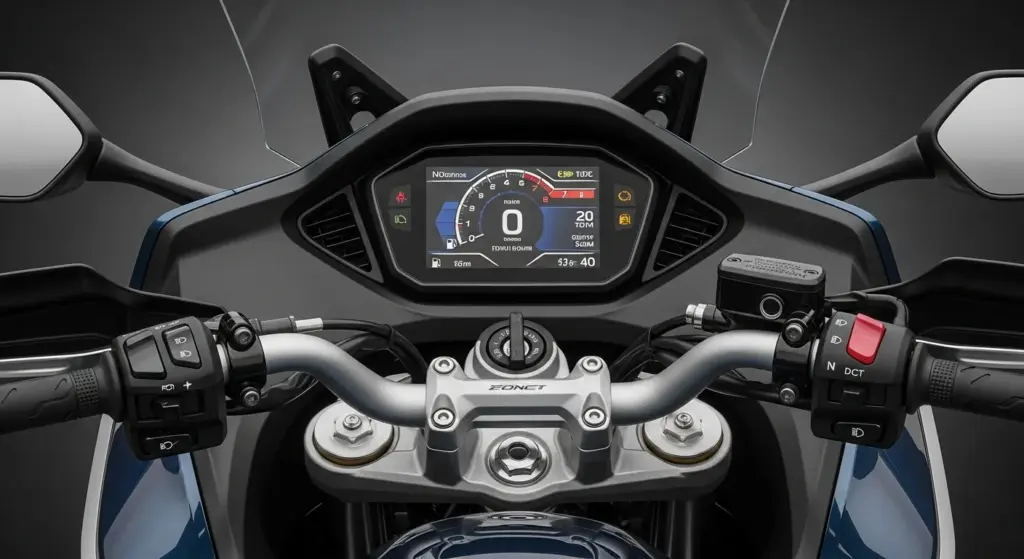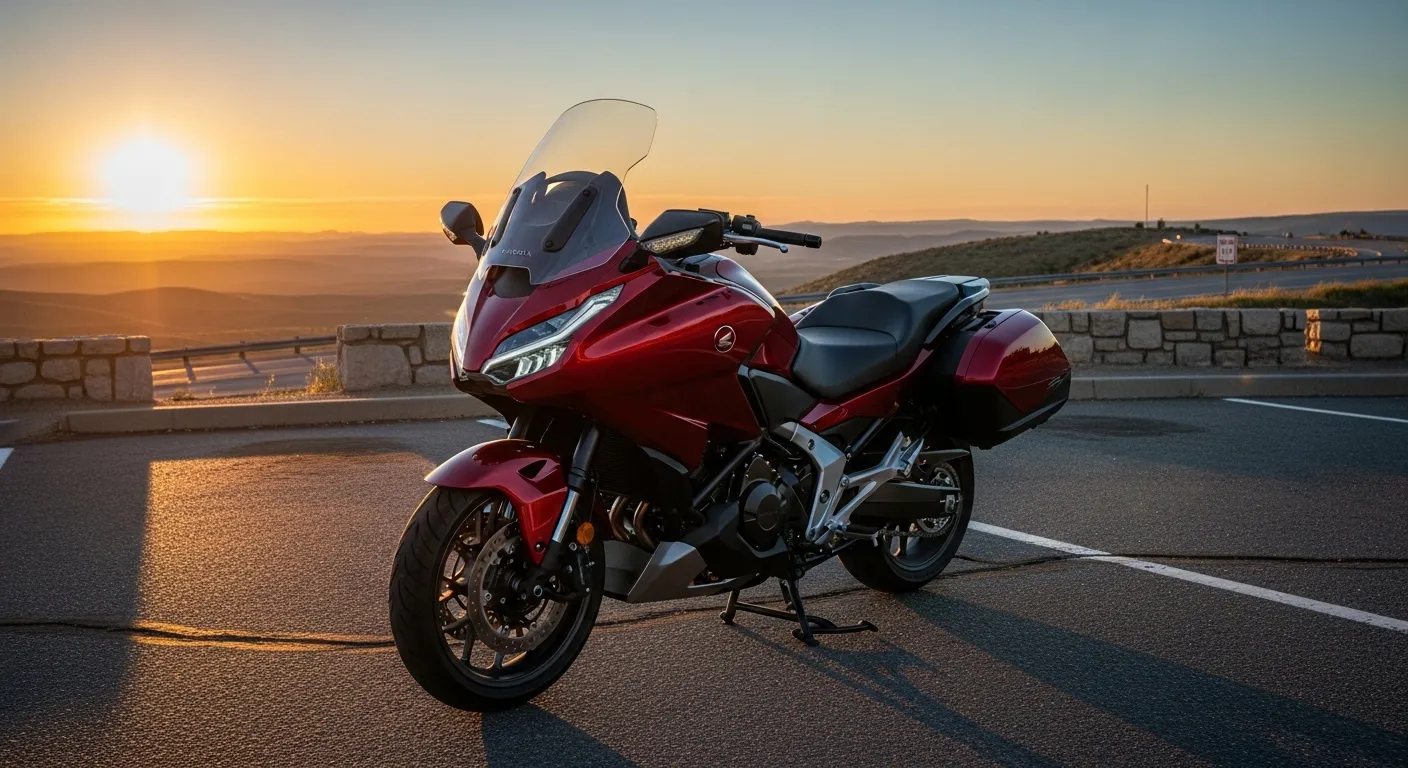In a landscape dominated by adventure-touring bikes and electrified two-wheelers, Honda’s decision to revive a pure sport-tourer with modern tech is a bold statement. Riders who shy from dirt but crave long-haul performance have been underserved. The 2025 Honda NT1100 DCT aims to fill that gap in the U.S. for 2025.
With rising fuel costs, longer weekend rides, and a renewed interest in comfortable, capable touring machines, the timing is right. For many American riders, the NT1100 DCT represents a fresh option: automatic transmission, modern electronics, and touring comforts — without tipping into full-on adventure bike bulk.
Because Honda already had a multi-year run in Europe, the U.S. debut doesn’t feel like an unproven experiment — more like a matured design entering a new market with confidence.
A Street-Focused Take on the Africa Twin Platform

Honda built the NT1100 DCT on the same engine architecture as the Africa Twin, but reworked it for road performance and agility.
Please take a look at this post as well: 2026 Suzuki GSX-R 40th Anniversary: What’s New & Why It Matters
They shortened the wheelbase by roughly 1.5 inches, steepened rake and reduced trail, and fitted more street-friendly suspension settings. The result: a bike that maneuvers nimbly through twisty backroads but still holds composure on the highway.
Also, unlike Europe where a manual-transmission version is offered, U.S. buyers get only the six-speed automatic DCT version — no clutch lever in sight.That automatic setup has matured over years in other Honda models, promising seamless shifts, reduced fatigue, and clutch-free control.
Key Specs & Real-World Impact
| Specification | Value | Real-World Implication |
|---|---|---|
| Engine | 1,084 cc liquid-cooled parallel twin | Plenty of torque and power for highway cruising, overtakes, and long-distance load hauling. |
| Power / Torque | ~101 hp / 86.2 lb-ft | Strong midrange punch, smooth delivery, usable in everyday and spirited riding. |
| Transmission | 6-speed DCT (auto + manual paddle) | Auto mode for relaxed cruising, or manual override for twisty roads. |
| Suspension | 43 mm Showa inverted fork, Pro-Link rear (5.9 in travel) | Balanced for firm yet comfortable touring — able to absorb imperfections without feeling wallowy. |
| Brakes | Dual 310 mm front (radial Nissin), single rear 256 mm | Strong and predictable stopping power, especially useful when loaded. |
| Seat Height | 32.3 in | Moderate height for a touring bike, accessible for many riders. |
| Fuel Capacity | 5.4 gal | Enough for long stretches between fuel stops on big rides. |
| Wet Weight | ~547 lbs (claimed) | Hefty, but manageable given the touring intent and DCT setup. |
Real-Life Impact:
On the highway, the NT1100 DCT glides with surpluses in torque and smooth DCT shifts. In twisty sectors, the shortened chassis and sharper rake help it change direction with more agility than many older tourers. Even when fully loaded with luggage (optional panniers), the 101 hp twin has enough headroom to maintain pace comfortably. The automatic transmission eliminates clutch fatigue during heavy stop-and-go, city commuting, or long canyon runs.
Please take a look at this post as well: Why Everyone’s Talking About the Kawasaki W230 in 2025
U.S. Launch, Price & Market Position
Honda officially introduced the NT1100 DCT to U.S. customers in March 2025, alongside updates to other models like the CB750 and CB1000 Hornet SP. The MSRP is set at $11,899 (plus a destination charge of $775). Dealers have the first units arriving in May 2025.
Compared to typical sport-tourers — which often exceed $14,000–16,000 in this class — the NT1100 DCT comes in as a value play. That pricing gives it an edge over rivals such as the Yamaha Tracer 9 GT and some BMW F-series machines, especially once accessories (panniers, top case) are tacked on.
Critics and reviewers have been generally positive, noting Honda’s choice to bring this matured platform, “with the bugs weeded out,” rather than a brand-new design.
Where It Shines — and Where It Might Fall Short
Strengths:
- DCT maturity: Riders who dislike shifting or want a more accessible machine will love the smooth automatic / paddle control.
- Balanced performance: Not overly extreme, but designed with everyday usability as well as touring in mind.
- Value: Strong spec package for under $12K base.
- Ergonomics and comfort: Good wind protection, adjustable screen, solid seat for long hours.
- Tech features: TFT display, connectivity, ride modes, torque control & IMU support.
Potential Weaknesses / Considerations:
- No manual version in U.S. may disappoint clutch purists.
- Weight & bulk: At ~547 lbs wet, it’s not nimble like a pure sportbike.
- Accessory cost: Panniers/top case are optional extras that add up.
- Suspension limits: It lacks semi-active damping in the U.S. version (which Europe versions sometimes offer).
Please take a look at this post as well: Royal Enfield Electric Lineup Grows With Flying Flea FF-C6
How It Stacks Up: Rivals & Alternatives
- Yamaha Tracer 9 GT: More sport orientation, but often comes at a higher price.
- BMW F 900 XR: Premium badge, more tech, possibly higher cost of ownership.
- Other Honda tourers: Compared to the Honda Africa Twin, the NT1100 is more street-focused and lower in height, though it sacrifices some off-road potential.
- Electric / Futuristic rivals: While not a direct competitor, the trend toward EVs looms — but the NT1100 DCT speaks to riders wanting internal combustion, ease, and touring comfort now.
What Riders Are Saying & Early Media Take
- Rider Magazine’s first rides in the U.S. found the DCT intuitive and comfortable — they say you’ll drop skepticism within minutes.
- Reviewers often cite that Honda has worked out early bugs thanks to European sales history.
- Autoweek calls it “an Africa Twin for the street” — same DNA but better suited for asphalt.
- Cycle News notes that at under $12K, the NT1100 DCT is “a lot of bike for the money” when stacked against premium rivals.
Social media reactions reflect cautious optimism: many riders say it’s the kind of tool you can tour with daily, without feeling like you’re compromising on performance.
🚦 Final Take & Who Should Buy It
The 2025 Honda NT1100 DCT offers one of the most compelling sport-touring packages to hit the U.S. in years. Its strengths lie in delivering an intuitive, comfortable, and tech-rich ride without the intimidation factor of massive displacement or expense. The automatic transmission is not a gimmick — it’s a matured, practical solution.
If you’re a rider who craves touring comfort, wants to avoid clutch fatigue, but still values spirited handling and highway capability — this is one of the top choices in 2025. Commuters who also take road trips will appreciate its all-around balance.
That said, if you’re a clutch purist, someone focused on ultralight sportbikes, or need off-road capability, this might not be your perfect match. But for what it sets out to do — being a versatile, practical sport-tourer — the NT1100 DCT delivers strongly. For U.S. riders interested in the evolving sport-touring scene, this is one to try early.
